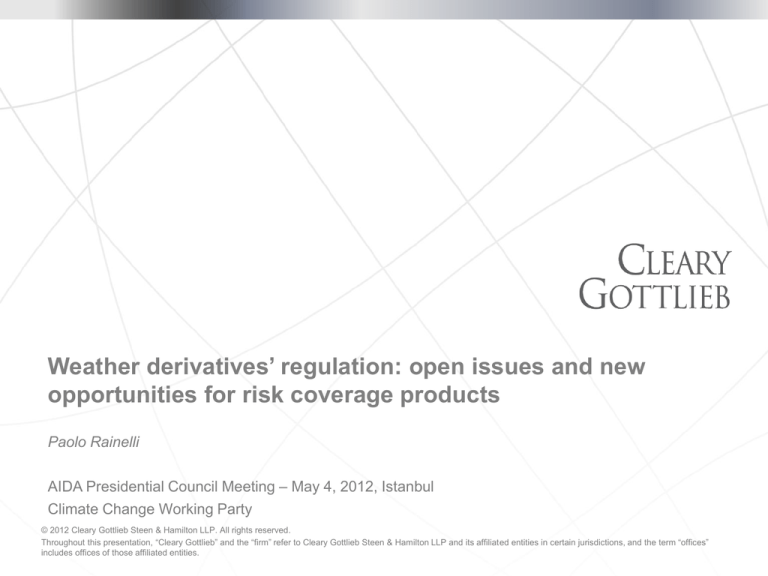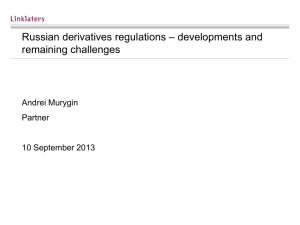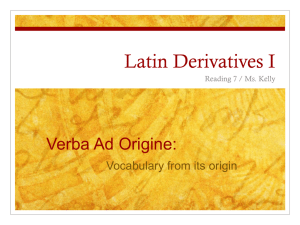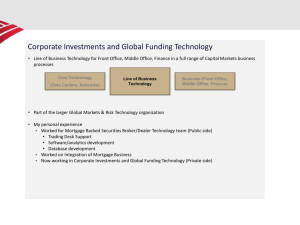
Weather derivatives’ regulation: open issues and new
opportunities for risk coverage products
Paolo Rainelli
AIDA Presidential Council Meeting – May 4, 2012, Istanbul
Climate Change Working Party
© 2012 Cleary Gottlieb Steen & Hamilton LLP. All rights reserved.
Throughout this presentation, “Cleary Gottlieb” and the “firm” refer to Cleary Gottlieb Steen & Hamilton LLP and its affiliated entities in certain jurisdictions, and the term “offices”
includes offices of those affiliated entities.
Weather derivatives
A derivative is a financial product, the value of which derives from an
underlying index, rate, commodity or other variable element.
The special feature of weather derivatives is that the underlying
element is represented by weather-related indexes such as
temperature, rainfall, snowfall, wind, etc.
Two variants: customized weather derivatives vs. standardized weather
derivatives (tradable).
Origin: Aquila Energy structured a dual-commodity hedge for
Consolidated Edison (USA ,1996)
However the weather component was embedded in the very first
derivative transactions: weather forecasts and renting of olive
mills/presses by Thales of Miletus (Asia Minor 600 B.C.).
2
“The insurance industry was not then receptive to requests to provide
non-catastrophic protection. Accordingly, the energy market was left to
fend for itself. Energy companies, realizing that the market was changing,
took control of their weather risk and created a new business around it”
Lynda Clemmons (former head of Enron Environmental Desk, 2002)
3
Some figures…
The weather derivatives market expanded from being a very small U.S.
energy product (back in 1997) to quickly become a USD 11.8 billion
industry by 2011 (WRMA).
A growing market (that survived its pioneers, namely Enron).
According to data collected by WRMA, during the 2010-2011 period:
the market for customized weather derivatives grew by nearly 30%;
the total notional value for OTC contracts rose to USD 2.4 billion;
the overall market grew to USD 11.8 billion (20% increase).
4
Who needs weather derivatives?
Number of potential “end-users”:
(i)
Energy (and other utilities);
(ii) Agriculture;
(iii) Travel;
(iv) Manufacturer of weather-driven seasonal products; and
(v) Insurance (covering third parties’ weather-related risks).
Traditional use of derivatives in the insurance business (e.g., hedging
currency risk, stock market fluctuations, interest rates) but weather
derivatives may also allow insurers “to cope with climate changes”
(Marcel Fontaine - AIDA World Congress 2010).
Together with CAT bond, they represent a form of alternative risk
transfer (ART) when reinsurance capacity is limited or too expensive.
5
Benefits of weather derivatives
Assuring smooth revenues and compensating for the loss of demand:
for instance a utilities company might want to hedge the decreased
revenues due to a warm winter.
Covering excess costs: for instance, industrial consumers of energy
might want to hedge the cost of purchased electricity associated with
peak load demand.
Reimbursing lost opportunity costs: firms operating in weather
dependant sectors might want to hedge the risks of stock-outs.
Stimulating sales: firms (particularly in the travel sector) might use
weather derivatives to back up their “money back guarantee” clauses
within their customer satisfaction policies .
Diversifying investment portfolios: financial investors – who are not
directly exposed to weather related risks – might want to take
advantage of the low correlation between returns associated with
weather and returns from other asset classes.
6
Types of weather derivatives
Floors grant downside protection when the underlying weather variable
falls below the established threshold (whereas the upside remains
unconstrained).
Cap derivatives provide compensation if the underlying weather
variable goes above a certain level.
Collars and swaps usually involve parties having opposite interests
exchanging their respective risks (one party buys a floor and sells a
cap).
Futures (most common type of publicly traded weather derivative at the
Chicago Mercantile Exchange) incorporate the commitment to deliver
or accept a commodity (e.g., temperature or other weather index) at a
certain time and at a certain price. Variations above or below that price
trigger a cash settlement between the buyer and seller.
7
Weather derivatives vs. Insurance Contracts
Weather derivative are (mostly) intended as risk-shifting instruments
Sounds familiar? YES
Debate around relationship between weather derivatives and insurance
contracts
Derivatives rapidly turned from a resource (alternative risk
management) into a threat (potential and/or actual competition with
traditional insurance policies).
The NAIC battle: in 2003 the National Association of Insurance
Commissioners (NAIC) released a draft white paper arguing that
weather derivatives were “disguised” insurance contracts and
recommending a legislative intervention on authorization and
monitoring of their issuance.
Unfair competition between heavily regulated insurance companies and
virtually unregulated players.
8
Weather derivatives vs. Insurance Contracts (2)
If weather derivatives were found to be disguised insurance policies,
only licensed insurance brokers would have been authorized to sell
such products.
Unsuccessful outcome of the 2003 NAIC battle: paper was never
released, immediate reactions by WRMA and International Swaps and
Derivatives Association (ISDA).
Despite the similarities between weather derivatives and weather-risk
insurances, functional equivalence must be distinguished from legal
equivalence.
Presumably the discussions on the different “legal nature” of weather
derivatives – at least in the USA – have come to an end.
9
Weather derivatives vs. Insurance Contracts (3)
The insured party:
must have an insurable risk with respect to a fortuitous event that is
capable of a financial estimate;
must “transfer” its “risk of loss” to the insurance company;
pays a “premium” to the company for assuming the risk;
in order to collect the indemnity, must provide evidence of an actual
loss and the payment is limited to an amount equal to the lesser of the
insured’s actual loss or the maximum amount of loss covered.
The insurance company:
assumes the risk as part of a larger program for managing loss by
holding a large pool of contracts covering similar risks (risk distribution
or risk spreading).
None of the statements above apply to weather derivatives
10
“The subject matter of a weather option is the specified weather
component and it is a conceptual impossibility for anyone to have an
economic interest in the elements”
WRMA’s answer to NAIC draft white paper , 2004
11
What’s going on?
Unenforceability issues in purely speculative environments (gambling
exceptio);
“Commodification” of weather indexes. Consolidation of weather
derivatives’ treatment as “commodity derivatives” (trying to address
overlap with insurance products and gambling issues);
Similar market structures.
Primary market : secondary market = insurance : reinsurance
Existence of regulatory constraints. In certain jurisdictions prohibition
for insurers or reinsurers to “sell” or issue weather derivatives (as they
are not insurances);
Disclosure/pre-contractual information
Pricing models (e.g., market based, actuarial) impact of climate change
Different tax (over premiums/price) and accounting treatments
12
What’s ahead for insurance companies?
A. TRADING. Insurance companies continue using weather derivatives
as alternative risk transfer tools/reinsurance products (a wellestablished and mature market);
B. ISSUANCE. Insurance companies start (or strengthen) the
issuance/sale of customized weather derivatives (requires regulatory
changes in certain jurisdictions and/or intra-group separation);
C. CONVERGENCE: a so-called “weather derivative component”
incorporated into traditional insurance products (affecting the
economics or the dynamics of the contract).
Probably new opportunities for non-catastrophic risk coverage products
13












